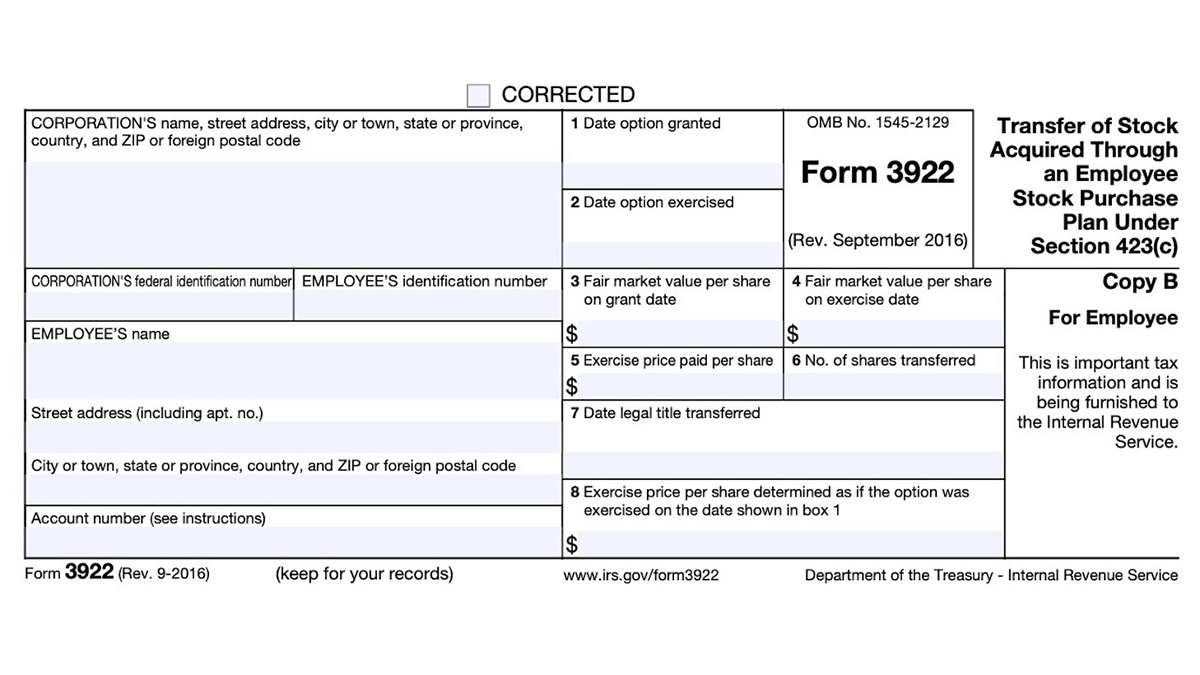Home>Finance>How To Report Involuntary Conversion On A Tax Return


Finance
How To Report Involuntary Conversion On A Tax Return
Published: October 28, 2023
Need help reporting involuntary conversion on your tax return? Our finance experts can guide you through the process step by step. Learn more today.
(Many of the links in this article redirect to a specific reviewed product. Your purchase of these products through affiliate links helps to generate commission for LiveWell, at no extra cost. Learn more)
Table of Contents
- Overview
- Understanding Involuntary Conversion
- Types of Involuntary Conversion
- Reporting Involuntary Conversion on Form 4684
- Section 1033 Deferral
- Calculating Gain or Loss
- Special Rules for Business and Investment Property
- Reporting Involuntary Conversion on Schedule D
- Deducting Losses on Involuntary Conversion
- Example of Reporting Involuntary Conversion on a Tax Return
- Frequently Asked Questions
- Conclusion
Overview
Reporting involuntary conversions on a tax return can be challenging for many taxpayers. Involuntary conversion occurs when property is seized, condemned, destroyed, or disposed of without the owner’s consent. This can happen due to natural disasters, accidents, or government actions.
When faced with an involuntary conversion, it is crucial to understand how to properly report it on your tax return. The reporting process ensures that you accurately calculate gains or losses associated with the conversion and claim any applicable deductions or deferrals.
In this article, we will delve into the intricacies of reporting involuntary conversions on a tax return. We will explore the different types of involuntary conversions, the specific forms to use, and the rules for calculating gains or losses. Furthermore, we will provide an example to illustrate these concepts in action.
By the end of this article, you will have a comprehensive understanding of how to handle involuntary conversions on your tax return, ensuring compliance with the Internal Revenue Service (IRS) regulations, and maximizing your tax benefits.
Understanding Involuntary Conversion
Involuntary conversion refers to the loss of property without the owner’s consent, typically due to unforeseen circumstances such as natural disasters, accidents, or government actions. Understanding the concept of involuntary conversion is essential when it comes to reporting it on your tax return.
There are two main types of involuntary conversions: complete conversions and partial conversions.
A complete conversion occurs when the entire property is destroyed or taken away, leaving the owner with no remaining interest. Examples include property destroyed by fire, flood, or government seizure.
A partial conversion, on the other hand, occurs when only a portion of the property is lost or destroyed, while the rest remains intact. An example of a partial conversion could be the acquisition of an easement on a land parcel.
When reporting an involuntary conversion on your tax return, you must determine whether it qualifies as a complete or partial conversion. This classification will dictate the specific reporting requirements and tax treatment.
It’s important to note that not all involuntary conversions result in a taxable event. In some cases, taxpayers may be eligible for deferral or exclusion of the gain resulting from the conversion, especially if the property is replaced within a specified time frame.
Next, we will explore the different types of involuntary conversions and their respective reporting guidelines to help you navigate the reporting process with confidence.
Types of Involuntary Conversion
Involuntary conversions can occur in various circumstances, each requiring specific reporting guidelines. Let’s explore the different types of involuntary conversions and their implications:
- Casualty or theft: This occurs when property is damaged, destroyed, or stolen due to unexpected events, such as fire, flood, or theft. In these cases, the taxpayer may be eligible to claim a deduction for the loss on their tax return.
- Condemnation or seizure: This type of involuntary conversion happens when the government acquires property for public use. The taxpayer may receive compensation for the condemned property, and the gain or loss must be reported on the tax return.
- Destruction or theft of money: If cash or money equivalents (such as stocks or bonds) are destroyed or stolen, the taxpayer may be able to claim a loss deduction on their tax return.
- Conversion of property for public purpose: In certain situations, property owners may be forced to give up a portion of their property for public use, such as for roads or utilities. The taxpayer may be compensated for the conversion, and reporting requirements apply.
- Involuntary conversion of business or investment property: This type of conversion occurs when business or investment property is taken away or destroyed without the owner’s consent. Special rules and reporting guidelines apply for these types of conversions.
It’s important to understand the specific implications and reporting requirements for each type of involuntary conversion. Failure to accurately report these conversions can result in penalties and unnecessary tax liabilities. Therefore, it’s advisable to consult with a qualified tax professional or refer to IRS resources for guidance.
Reporting Involuntary Conversion on Form 4684
When it comes to reporting involuntary conversions on your tax return, Form 4684, “Casualties and Thefts,” is the primary form to use. This form helps calculate the gain or loss resulting from the conversion and determines any tax benefits or deductions you may be entitled to.
Here’s a step-by-step guide on how to complete Form 4684 for reporting involuntary conversions:
- Identify the type of involuntary conversion: Determine the specific category under which your involuntary conversion falls, such as casualty, theft, condemnation, or destruction of money.
- Provide necessary information: Fill in your personal information, including name, social security number, and filing status, at the top of the form.
- Describe the property: Provide a detailed description of the property involved in the involuntary conversion, including its type, location, and ownership details.
- Estimate the fair market value before the conversion: Determine the fair market value of the property immediately before the conversion. This information is necessary for calculating the gain or loss.
- Report the amount of any reimbursement: If you received any reimbursement or insurance proceeds related to the conversion, report the amount on the appropriate line of the form.
- Calculate the gain or loss: Subtract the fair market value after the conversion from the fair market value before the conversion to determine the gain or loss. Enter this amount on the designated line.
- Determine any deductible losses: If the conversion resulted in a loss, you may be eligible to claim a deductible loss on your tax return. Follow the instructions on Form 4684 to determine the deductible amount.
- Complete the other sections of the form: Form 4684 includes additional sections for reporting casualty and theft losses that do not qualify as involuntary conversions. Fill out these sections if applicable.
- Transfer the information to your tax return: Once you have completed Form 4684, transfer the information to the appropriate section of your tax return, such as Schedule D for capital gains and losses.
It’s crucial to accurately complete Form 4684 and maintain supporting documentation related to the involuntary conversion. By doing so, you can ensure compliance with IRS regulations and maximize your tax benefits.
Section 1033 Deferral
For qualifying involuntary conversions, taxpayers may be eligible for a deferral of the gain on the conversion under Section 1033 of the Internal Revenue Code. The deferral allows taxpayers to postpone the recognition of the gain if they acquire replacement property within a specified timeframe.
To qualify for the Section 1033 deferral, the following criteria must be met:
- Timely replacement: The replacement property must be acquired within a specific period, which is generally two years from the end of the tax year in which the conversion occurred. The IRS may grant extensions in certain cases, such as federally declared disasters.
- Similar or related property: The replacement property must be similar or related in service or use to the converted property. This means that the replacement property should serve a similar function or be used in a similar manner as the original property.
- Cost basis adjustment: The basis of the replacement property is generally determined by subtracting the deferred gain from the cost or adjusted basis of the replacement property. This adjustment helps ensure that the deferred gain is eventually recognized when the replacement property is disposed of.
It’s important to note that the Section 1033 deferral is not automatic. Taxpayers must elect to defer the gain on their tax return by including the necessary information and calculations. Additionally, if the replacement property is sold or disposed of before the deferral period expires, the deferred gain must be recognized in the year of the sale.
Consulting a tax professional is highly recommended when considering the Section 1033 deferral. They can provide guidance on eligibility, calculations, and reporting requirements to ensure compliance with IRS rules and maximize tax benefits.
Calculating Gain or Loss
When reporting an involuntary conversion on your tax return, it is essential to accurately calculate the gain or loss resulting from the conversion. This calculation determines the taxable amount and helps establish the basis for any potential deductions or deferrals. Here’s how to calculate the gain or loss:
- Determine the fair market value (FMV) before the conversion: The FMV is the estimated price that the property would have sold for on the open market before the conversion occurred. This value can be determined through appraisals, comparable sales data, or other relevant factors.
- Determine the fair market value (FMV) after the conversion: The FMV after the conversion is the estimated price that the remaining portion of the property, if applicable, would sell for on the open market after the conversion occurred.
- Calculate the gain or loss: Subtract the FMV after the conversion from the FMV before the conversion to determine the gain or loss. If the result is a positive number, it represents a gain. If it is a negative number, it indicates a loss.
- Incorporate reimbursement or insurance proceeds: If you received any reimbursement or insurance proceeds related to the conversion, subtract this amount from the calculated gain or add it to the calculated loss. This adjustment accounts for any compensation received.
- Consider applicable basis adjustments: Depending on the circumstances of the involuntary conversion, there may be basis adjustments that need to be considered. For example, if the replacement property is acquired, the basis of the replacement property may be adjusted by the amount of the gain deferred under Section 1033.
It is crucial to ensure that all calculations are accurate, as any errors may result in incorrect reporting on your tax return. Keep in mind that the specific reporting requirements and treatment of gains or losses may vary depending on the type of involuntary conversion and any applicable tax provisions or regulations.
Consulting with a tax professional or referring to IRS resources can provide further guidance on the specific calculations and reporting requirements for your situation.
Special Rules for Business and Investment Property
When it comes to reporting involuntary conversions of business and investment property, there are specific rules and considerations that taxpayers need to be aware of. These special rules apply to help determine the gain or loss and the tax treatment of the conversion. Here’s a closer look:
Business Property:
- Like-kind exchanges: In some cases, businesses may be able to defer the gain on an involuntary conversion by participating in a like-kind exchange. This allows the business to replace the converted property with a similar property without recognizing the gain immediately.
- Recapture of depreciation: If the converted property was previously depreciated for tax purposes, the gain on the involuntary conversion may be subject to depreciation recapture. This means that a portion of the gain will be taxed at ordinary income rates.
- Net operating losses: If the involuntary conversion results in a loss for the business, it may be possible to carry back or carry forward the net operating losses to reduce taxable income in other years.
Investment Property:
- Capital gains treatment: Generally, the gain or loss on the involuntary conversion of investment property is treated as a capital gain or loss. This means that the gain may be eligible for preferential tax rates, depending on the taxpayer’s income level.
- Loss limitations: The deductibility of investment property losses is subject to limitations. These limitations may restrict the amount of loss that can be recognized in a given tax year and may require carryover of any excess losses to future years.
It’s essential to understand the specific rules and considerations that apply to your business or investment property when reporting involuntary conversions. The IRS provides guidelines and instructions to help taxpayers navigate these special rules, but consulting with a tax professional is advisable to ensure compliance and maximize tax benefits.
Reporting Involuntary Conversion on Schedule D
When it comes to reporting the gain or loss from an involuntary conversion on your tax return, the information is typically transferred to Schedule D, “Capital Gains and Losses.” Schedule D is used to report capital gains and losses, including those resulting from involuntary conversions.
Here’s how to report the gain or loss from an involuntary conversion on Schedule D:
- Complete Form 4684: Before reporting on Schedule D, make sure you have properly completed Form 4684, “Casualties and Thefts,” as it provides the necessary information to calculate the gain or loss. Transfer the relevant details from Form 4684 to Schedule D.
- Classify the property: Determine whether the converted property is classified as a short-term or long-term capital asset based on your holding period. Short-term assets are held for one year or less, while long-term assets are held for more than one year.
- Enter the sales price: Report the sale price or the value of any consideration received for the involuntary conversion on the appropriate line of Schedule D. This amount represents the total proceeds from the conversion.
- Report the basis: Enter the adjusted basis of the converted property on the corresponding line of Schedule D. The adjusted basis takes into account any adjustments made to the original cost basis, such as depreciation or improvements.
- Calculate the gain or loss: Subtract the basis from the sales price to determine the gain or loss on the involuntary conversion. If the result is a positive number, it represents a capital gain. If it is a negative number, it indicates a capital loss.
- Consider additional reporting requirements: Depending on the specific circumstances of the involuntary conversion, such as depreciation recapture or like-kind exchanges for business property, additional forms or schedules may be required to accurately report the transaction.
- Complete Schedule D: Follow the instructions provided on Schedule D to report the capital gain or loss resulting from the involuntary conversion. This includes transferring the calculated gain or loss to the appropriate lines and applying any applicable tax rates.
It is crucial to accurately complete Schedule D and maintain supporting documentation for the involuntary conversion. By doing so, you can ensure compliance with IRS regulations and accurately report your capital gains or losses.
Consulting with a tax professional or referring to IRS resources can provide further guidance on the specific reporting requirements and treatment of involuntary conversions on Schedule D.
Deducting Losses on Involuntary Conversion
If an involuntary conversion results in a loss, taxpayers may be eligible to deduct that loss on their tax return. Deducting losses can help offset taxable income and potentially result in a lower tax liability. Here’s what you need to know about deducting losses on an involuntary conversion:
Business Property:
- Deductible loss: If the involuntary conversion of business property results in a loss, the loss is generally deductible on the taxpayer’s tax return.
- Net operating loss (NOL) carrybacks and carryforwards: If the loss exceeds the taxpayer’s current year’s income, they may be able to carry it back to prior years or carry it forward to offset future years’ income through a Net Operating Loss (NOL) deduction.
- Special rules for like-kind exchanges: If a business property is involuntarily converted and the taxpayer participates in a like-kind exchange, they may need to adjust the basis of the replacement property.
Investment Property:
- Deductible loss limitations: Deducting investment property losses from involuntary conversions is subject to limitations. The deductible loss may be limited based on factors such as the taxpayer’s income level and the type of investment property.
- Capital loss treatment: Losses resulting from the involuntary conversion of investment property are generally treated as capital losses. Capital losses can be used to offset capital gains and can also be used to reduce the taxpayer’s other taxable income, subject to certain limits.
It’s important to carefully review the IRS guidelines and consult with a tax professional when deducting losses from an involuntary conversion. They can provide guidance on the specific requirements, limitations, and reporting procedures. Maintaining detailed records, including documentation of the loss and any related transactions, is vital to substantiate the deduction and support it in case of an IRS audit.
By correctly deducting losses on an involuntary conversion, taxpayers can mitigate the financial impact of the loss and potentially reduce their tax liability.
Example of Reporting Involuntary Conversion on a Tax Return
To better understand how to report an involuntary conversion on a tax return, let’s look at an example:
Imagine you owned a commercial property that was severely damaged by a flood and was deemed uninhabitable. As a result, the property had to be demolished. The fair market value of the property before the flood was $500,000.
You had an insurance policy that covered such events, and the insurance company reimbursed you $350,000 for the property’s loss. To calculate the gain or loss from the involuntary conversion, the steps would be as follows:
- Determine the fair market value before the conversion: $500,000
- Determine the fair market value after the conversion: $0 (since the property was demolished)
- Calculate the gain or loss: $500,000 (before conversion) – $0 (after conversion) = $500,000 (loss)
- Incorporate the reimbursement: $500,000 (loss) + $350,000 (reimbursement) = $150,000 (final loss)
Next, you would report this involuntary conversion on your tax return:
- Complete Form 4684, providing all necessary details about the property, the conversion, and the reimbursement received.
- Transfer the information from Form 4684 to Schedule D, including the final loss of $150,000.
- Follow the instructions on Schedule D to report the loss and calculate the impact on your overall tax liability.
Remember to consult with a tax professional to ensure accuracy and compliance with IRS regulations. They can provide specific guidance based on your unique situation and help maximize your tax benefits.
By accurately reporting the involuntary conversion and deducting the appropriate loss, you can minimize the financial impact and potentially receive tax relief.
Frequently Asked Questions
1. Can I claim a deduction for an involuntary conversion if I receive insurance proceeds?
Yes, if you receive insurance proceeds as a result of the involuntary conversion, you may still be eligible to claim a deduction. However, you will need to subtract the amount of the insurance proceeds from the loss when calculating the final deductible amount.
2. What happens if I don’t replace the converted property within the specified timeframe?
If you fail to replace the converted property within the timeframe specified by the IRS, you will need to recognize the gain on your tax return. However, there may be alternatives available, such as the Section 1033 deferral, which allows you to postpone the recognition of the gain if certain conditions are met.
3. Do I need to report an involuntary conversion if it results in a loss?
Yes, it is important to report an involuntary conversion even if it results in a loss. By properly reporting the loss on your tax return, you may be eligible for tax deductions or other benefits that can help offset other income.
4. What records should I keep to support an involuntary conversion on my tax return?
It is crucial to keep detailed records related to the involuntary conversion. This includes documentation of the events causing the conversion, any insurance reimbursements received, and any calculations or valuations used to determine the gain or loss. These records will help support your claims and may be required in case of an IRS audit.
5. Can I claim a deduction for an involuntary conversion on my state tax return as well?
The deductibility of involuntary conversions on state tax returns varies depending on the specific state’s tax laws. Some states may conform to the federal tax treatment, while others may have their own rules and guidelines. It is advisable to consult with a tax professional or review the state tax laws to determine the applicable deductions for involuntary conversions.
These FAQs aim to provide general information about reporting involuntary conversions on a tax return. However, it’s important to consult with a tax professional who can provide personalized advice based on your individual circumstances.
Conclusion
Reporting involuntary conversions on a tax return can be complex, but it is a necessary step to accurately calculate gains or losses and claim any applicable deductions or deferrals. By understanding the different types of involuntary conversions and following the specific reporting rules, you can ensure compliance with IRS regulations and maximize your tax benefits.
When faced with an involuntary conversion, it is crucial to consult with a tax professional who can provide personalized guidance based on your specific situation. They can help you navigate the reporting process, advise on potential deductions or deferrals, and ensure accurate calculations.
Remember to maintain thorough documentation to support your claims and keep records of all transactions and events related to the involuntary conversion. This will not only assist you in reporting on your tax return but also serve as a valuable resource in case of an IRS audit.
While reporting involuntary conversions may seem daunting, with the right knowledge and guidance, you can fulfill your reporting obligations and potentially receive tax relief. Stay informed, seek professional advice when needed, and ensure compliance to make the most of your tax situation when faced with an involuntary conversion.














